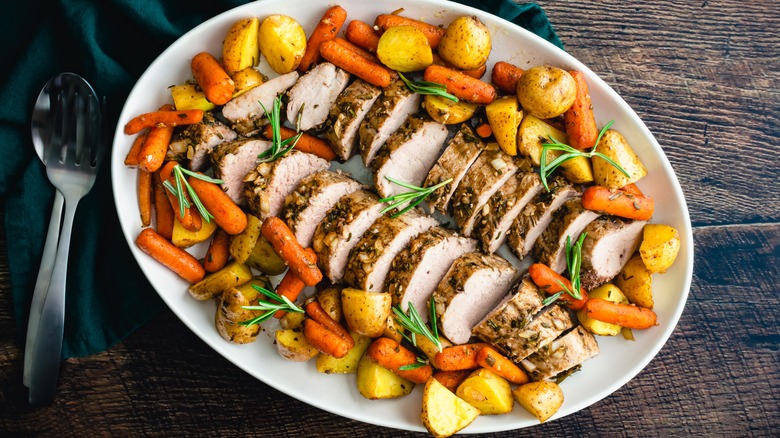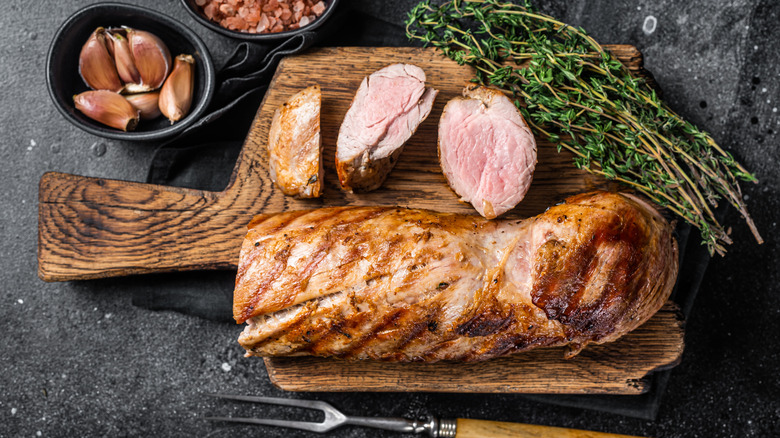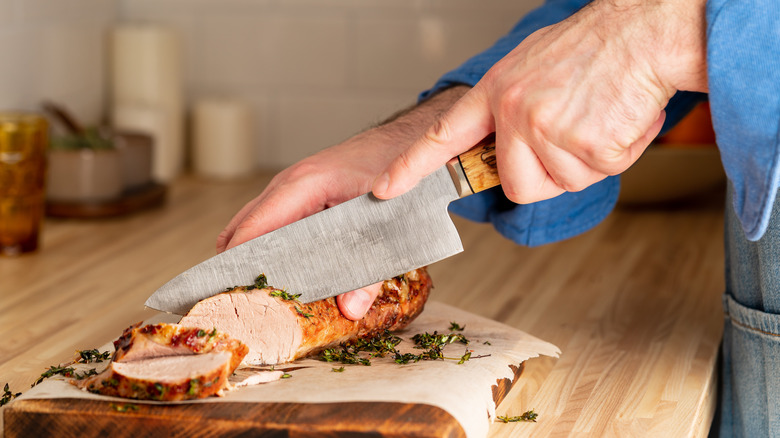The Cooking Tip You Need For Restaurant Quality Pork Tenderloin
The number one question that most home chefs need to answer is "what's for dinner?" While many of us might dream of having an inexpensive pork shoulder that's been slow roasting all day, not all of us have the luxury to do so. That's where the pork tenderloin comes in. It's a leaner cut of meat that is just as packed with flavor and tender texture. For this reason, pork tenderloin is a great cut of meat to always keep on hand. Roast pork tenderloin is easy enough to put together for an easy weeknight dinner, and it can also be dressed up for holidays like Easter or Christmas.
MasterClass says that this delicate cut of meat comes from the section of the pig that runs along its spine. This section isn't weight-bearing or used for movement, and so it has an incredibly delicate texture. However, Kitchn adds that the drawback to this cut is that it can also dry out easily. While it is a fairly easy meat to prepare, this one detail means that it takes some careful handling not to spoil. Thankfully, we've got a great method to get a juicy and delicious pork tenderloin every single time.
Why you need to use a two-step method for tenderloin
Getting the perfect cut of pork tenderloin takes two different cooking methods. According to Epicurious, the best way to cook pork tenderloin is to sear it in a pan, and then transfer it to the oven. This method creates a gorgeous brown crust on the outside of the tenderloin, before cooking the inside gently inside the oven.
As Exploratorium points out, a good sear is the secret weapon to any roasted meat. As meat is seared, it expels excess moisture, resulting in the Maillard reaction, which gives the browned meat its delicious flavor. Webstaurant Store claims that these reactions produce the signature brown crust of well-roasted meat, but it also forms the chemical compounds responsible for the illusive "umami" or "savory" taste.
These reactions typically only occur at temperatures well over 200 degrees Fahrenheit, per Exploratorium. However, Kitchn claims that cooking your pork past an internal temperature of 145 degrees Fahrenheit runs the risk of drying it out. By searing your pork tenderloin first, you get those delicious umami flavors and crisp crust without any risk of overcooking the interior. Then, just let it rest in the oven long enough to finish cooking, and you'll never have to worry about a dry tenderloin again.
How to sear and roast
This method is also easy to follow, and perhaps even more importantly, it doesn't take any specialized equipment or skills. Epicurious says to start by heating a pan over medium-high heat. When it's nice and hot, add your tenderloin. Turn it so that all sides are browned evenly. If your pan was heated well enough, this should happen relatively quickly. If you've been using an oven-safe pan, you can transfer it straight to a preheated oven set at 450 degrees Fahrenheit. Otherwise, carefully move the tenderloin from the pan to a baking sheet inside the oven.
If you're the type of cook who likes to experiment with recipes, you might try reversing this method by roasting the pork tenderloin in the oven, and then searing it (via Cook's Illustrated). Assuming all goes as expected, you should wind up with a similar result. This recipe also goes a step further by tenderizing the tenderloin into uniform one-inch pieces before cutting it crosswise. This will give more uniform cooking conditions, but it certainly isn't required.


